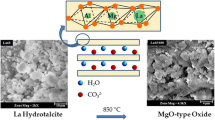Summary
The hydrothermal synthesis of kaolinite from various alumina and silica starting materials reacted at 200°C in aqueous solutions of oxalic acid and H2SO4 with the corresponding saturated water vapour pressure, in periods of time from 10 to 25 days, has been followed by X-ray diffraction measurements, scanning electron microscopy, and energy dispersive analysis of the products. The temperature and time periods of reactions were chosen on the basis of previously collected data on the effects of H4EDTA, a complex-forming agent, and of H2SO4, an inorganic acid, on the rate of formation of kaolinite. Aluminium-complexing acids increase the rate of formation or decrease the temperature of formation of kaolinite as shown by evidence from X-ray diffraction patterns. The influence of the starting materials as sources of aluminum, amorphous aluminum hydroxides, pseudoboehmite, allophane or gibbsite, has also been examined by X-ray diffraction, scanning electron microscopy, and by energy dispersive analysis. Scanning electron micrographs indicated that silica is a more mobile phase than alumina, based on the progressive formation of a thin coating on gibbsite during early reaction, then by growth of clusters of platy crystals of kaolin, and finally by production of pellets of stacked crystal flakes. Where gibbsite was used in the reaction mixture, boehmite was commonly observed as an intermediate phase.
Zusammenfassung
Die hydrothermale Synthese von Kaolinit aus verschiedenen tonerde- und kieselsäurehaltigen Ausgangsstoffen, bei 200°C in wäßrigen Oxal- und Schwefelsäure-Lösungen und entsprechendem gesättigten Wasserdampfdruck in Zeiträumen von 10 bis 25 Tagen durchgeführt. wurde durch Röntgen-Diffraktions- und Scanning-Elektronen-mikroskopische Messungen sowie Energie-Streuungs-Analyse auf gewonnenen Proben untersucht. Die Wahl der Temperatur- und Zeit-Abschnitte der Reaktion erfolgte auf Grund vorgesammelter Daten über die Einwirkungen von H4EDTA, eines Komplexe bildenden Werkstoffes, und von H2SO4, einer organischen Säure, auf die Bildungsgeschwindigkeit des Kaolinits.
Aluminiumkomplexe bildende Säuren beschleunigen die Kaolinitbildung bzw. senken die Temperatur derselben, wie dies aus den Röntgen-Diffraktionsmodellen zu ersehen ist. Der Einfluß der Ausgangsstoffe als Aluminiumquellen — amorphe Aluminium-Hydroxide, Pseudoböhmit, Allophan oder Gibbsit — wurde ebenfalls durch Röntgen-Diffraktion, Elektronen-Mikroskopie und energiedispersive Analyse untersucht. Scanning-Mikrogramme lassen erkennen, daß Kieselsäure eine mobilere Phase darstellt als Tonerde, gekennzeichnet durch fortschreitende Bildung von Überzügen während der anfänglichen Reaktion, weiterhin durch Anhäufung plattiger Kristalle und letztlich durch Bildung von Pellets gestapelter Kristallflocken. Bei Verwendung von Gibbsit in der Reaktionsmischung wurde gewöhnlich Böhmit als Zwischenphase festgestellt.
Similar content being viewed by others
References
Dennfeld, F., Siffert, B., Wey, R. 1970: Étude de l'influence des complexants de l'aluminium et du broyage des hydroxides d'aluminium sur la formation hydrothermale de la kaolinite. Bull. Gr. fran. ArgilesXXII, 179–190.
De Kimpe, C. R., Gastuche, M. C., 1964: Low temperature synthesis of kaolin minerals. Amer. Min.49, 1–16.
—, 1969: Crystallization of kaolinite at low temperature from alumino-silica gel. Clays Clay Minerals17, 37–38.
—,Kodama, H., Rivard, R., 1981: Hydrothermal formation of kaolinite-like product from non-crystalline aluminosilicate gels. Clays Clay Minerals29, 446–450.
Eberl, D., Hower, J., 1975: Kaolinite synthesis: The role of the Si/Al and (Alkali)/(H+) ratio in hydrothermal synthesis. Clays Clay Minerals23, 301–309.
Hem, J. D., Lind, C. J., 1974: Kaolinite synthesis at 25°C. Science184, 1171–1173.
La Iglesia, A. F., Galan, E., 1975: Halloysite-kaolinite transformation at room temperature. Clays Clay Minerals23, 109–113.
Kittrick, J. A., 1970: Precipitation of kaolinite at 25°C and 1 atm. Clays Clay Minerals18, 261–268.
Lahodny-Šarc, O., 1968: Étude de quelques produits résultant de l'altération de la bauxite blanche yougoslave. Bull. Gr. fran. ArgilesXX, 131–136.
—,Mihelčić-Gostiša, B., Karšulin, M., 1969: On the structure and thermal behavior of allophanic prokaolin. Travaux du Comité internat. bauxite etc., Académie youg. sc.6, 13–25.
Lahodny-Šarc, O., Došen-Šver, D., Bidjin, D., 1976: The influence of complexing agents on the hydrothermal synthesis of kaolinite. Seventh Conf. on Clay Minerals & Petrology, Karlovy Vary, 153–160.
—,Keller, W. D., 1981: Scanning electron micrography of hydrothermally synthesized kaolin and parent materials during synthesis reactions. Tschermaks Min. Pert. Mitt.28, 265–276.
Lineares, J., Huertas, F., 1971: Kaolinite: Synthesis at room temperature. Science171, 896–897.
Noll, W., 1936: Über die Bildungsbedingungen von Kaolin, Montmorillonit, Sericit, Pyrophyllit und Analcim. Min. Petr. Mitt.48, 210–246.
Roy, R., Osborn, E. F., 1952: Studies in the system alumina-silica-water. Problems of Clay and Laterite Genesis Symposium, pp. 76–80.
—, 1954: The system Al2O3−SiO2−H2O. Amer. Min.39, 853–885.
Siffert, B., Wey, R., 1961: Sur la synthèse de la kaolinite à température ordinaire. C. R. Acad. Sci. Paris253, 142–144.
—, 1962: Quelques réactions de la silice en solution: la formation des argiles. Mem. Serv. Carte Geol. Als. Lor.21, 1–84.
Siffert, B., Dennfeld, F., 1971: Étude de l'influence des acides minéraux forts sur la synthèse de la kaolinite à partir du mélange gibbsite, silice amorphe. Bull. Gr. fran. Argiles23, 91–106.
—, 1978: Genesis and synthesis of clays minerals: Recent developments and future prospects. Internat. Clay Conference: Developments in Sedimentology, 27, pp. 337–347. Amsterdam: Elsevier.
Author information
Authors and Affiliations
Additional information
With 16 Figures
Rights and permissions
About this article
Cite this article
Lahodny-Šarc, O., Došen-Šver, D. & Keller, W.D. Hydrothermal synthesis of kaolinite illustrated by X-ray diffractograms and scanning electron micrographs, part II. TMPM Tschermaks Petr. Mitt. 32, 235–246 (1984). https://doi.org/10.1007/BF01081615
Received:
Accepted:
Issue Date:
DOI: https://doi.org/10.1007/BF01081615



